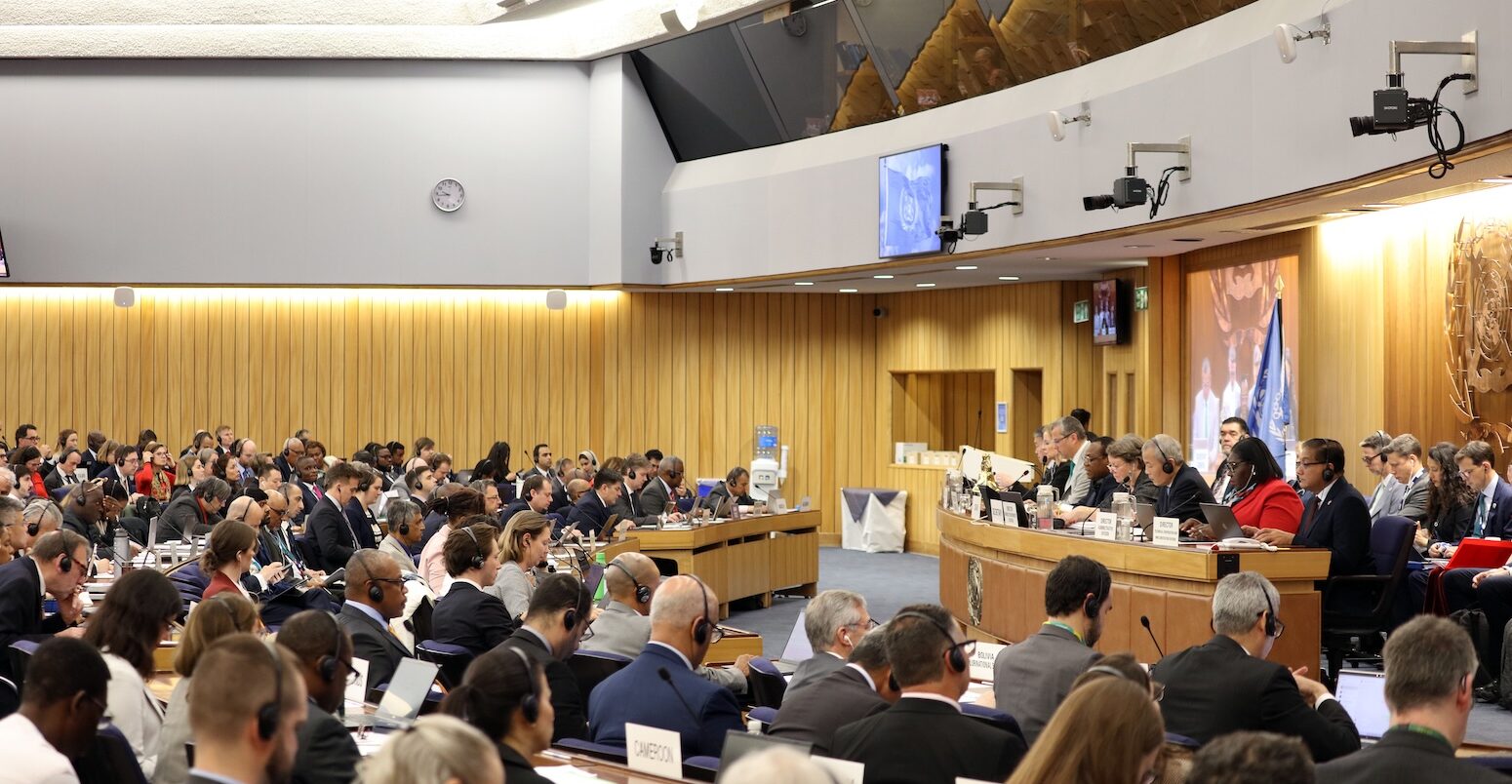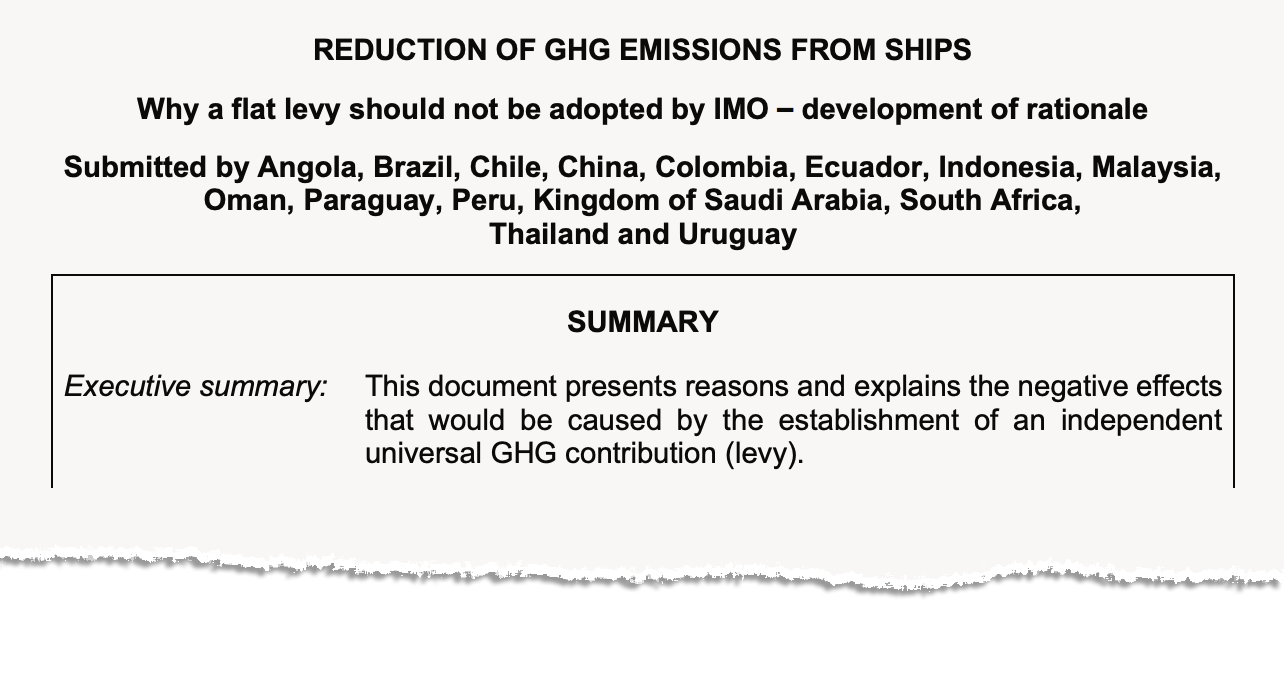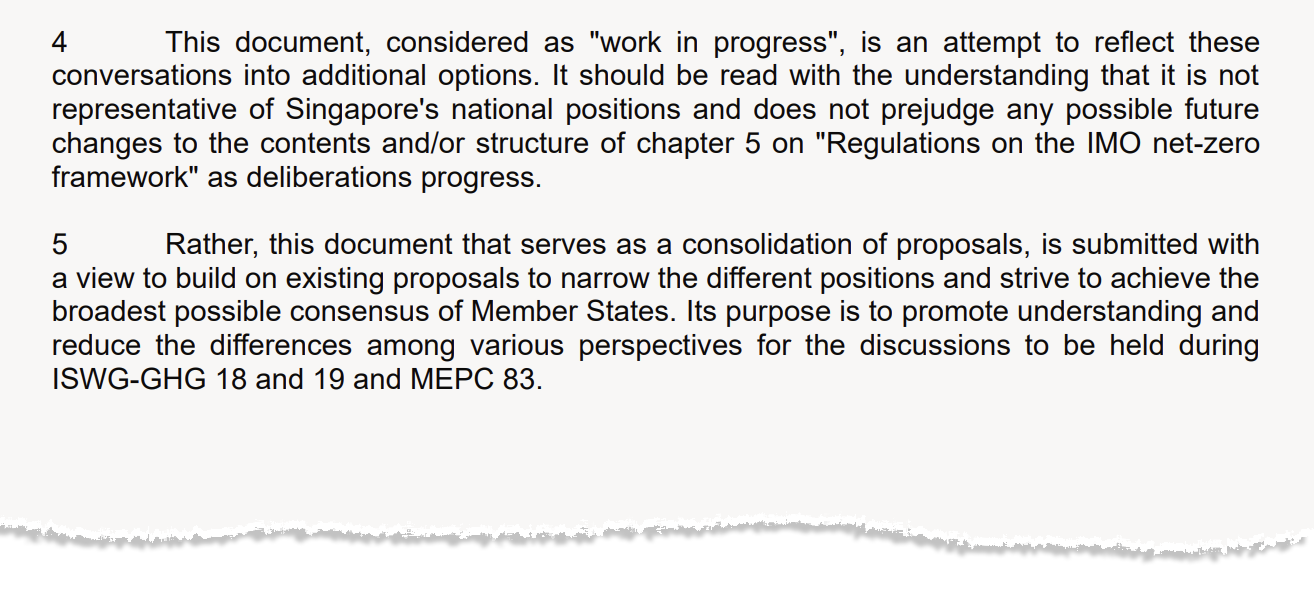
Q&A: Nations agree carbon-pricing system to steer shipping towards net-zero
Josh Gabbatiss
04.11.25Josh Gabbatiss
11.04.2025 | 4:34pmNations have agreed to introduce a worldwide carbon-pricing system for international shipping to drive the sector towards net-zero emissions by 2050.
A pivotal meeting at the UN’s International Maritime Organization (IMO) in London revolved around efforts to make ship owners pay for their emissions and transition to cleaner fuels.
Negotiations were fractious, with Pacific island nations initially leading a large and diverse group that wanted a universal shipping levy to raise money for climate action.
They faced opposition from a group of emerging economies and petrostates, who argued that such a levy would harm global trade and drive up commodity prices.
Meanwhile, the US withdrew its delegation from the talks midway through, calling efforts to put a price on carbon “blatantly unfair”.
Efforts to find a consensus at the IMO’s 83rd Marine Environment Protection Committee (MEPC83) meeting saw nations coalesce around a “bridging” proposal involving a credit-trading scheme.
After a week of intense negotiations, talks came to a dramatic climax when Saudi Arabia called for a vote and a compromise deal was pushed through with a majority.
While some welcomed an unprecedented move to significantly put a price on a high-polluting industry’s emissions, campaigners and climate experts noted that the final outcome would fall short of ambitions for net-zero shipping.
- Why were nations discussing new climate policies for shipping?
- What options had nations proposed to cut shipping emissions?
- How did countries agree to cut emissions from ships?
- What is in the final ‘net-zero framework’?
Why were nations discussing new climate policies for shipping?
Back in 2023, the member states of the IMO agreed that the entire international shipping sector would cut its greenhouse gas emissions to net-zero “by or around 2050”.
This was the culmination of nearly three decades of negotiations – frequently plagued by delays – concerning the climate impact of shipping.
These talks are significant because ships produce around 3% of global emissions and international shipping is not covered by climate pledges made by nations under the Paris Agreement.
Beyond the net-zero target – and interim emissions targets of up to a 30% emissions reduction by 2030 and up to 80% by 2040 – the 2023 negotiations left crucial elements undecided. Nations agreed to continue discussing two “measures” that would be used to enforce the shipping industry’s climate targets.
First, a measure to bring in an emissions pricing system that could both encourage ships to cut emissions and raise money for climate action.
The second measure is a global marine fuel standard that would gradually phase in low-carbon fuels for ships around the world.

Negotiations have continued in the intervening years. Parties agreed at a meeting in 2024 on a “possible draft outline” of an “IMO net-zero framework”, containing the pricing system and emissions standard.
If adopted, these would, ultimately, be slotted into Annex VI of the existing MARPOL Convention, which governs pollution from ships.
Yet the slow pace of IMO negotiations meant that a final decision on the shape and strength of the two measures was not due to be agreed until 2025. Nations were set to finalise a draft legal text in April and adopt it at another meeting in October before it finally comes into force in 2028.
While the net-zero target established in 2023 was not legally binding, the measures being discussed have the potential to be.
As a result, observers have noted that these policies are the essential elements that will determine the future emissions trajectory of global shipping.
Moreover, this means that decisive action at the IMO could yield substantial outcomes for a high-emitting sector, amid faltering global climate action. This sentiment was voiced by Vanuatu climate minister Ralph Revenganu, who told journalists at MEPC83:
“We see the UNFCCC isn’t moving fast enough – and this is the great opportunity. If this is adopted here, it will be a game-changer for climate. It would be the first industry-wide measure adopted by a multilateral UN organisation with much more teeth than we could get in the UNFCCC process.”
Unlike COP climate summits, decision-making at the IMO does not need to be unanimous. Nevertheless, the net-zero target was passed unanimously and secretary general Arsenio Dominguez had indicated he did not want to push through a majority vote at MEPC83.
The talks also took place against a backdrop of chaotic geopolitics, following US president Donald Trump’s administration issuing sweeping trade tariffs over recent weeks. The US caused a stir mid-way through the week when it withdrew from the talks, urging other countries to join it and calling proposed carbon pricing systems “blatantly unfair”.
In the end, the absence of the US – which is not one of the biggest players in international shipping – did not overtly upend the talks.
What options had nations proposed to cut shipping emissions?
Going into the MEPC83 talks, there were deep divisions between nations about how the new climate policies should be structured.
The biggest disagreements centred around the mechanism that would be used to put a price on shipping emissions. The main proposals – and those supporting them – are laid out below.
Emissions levy
One major idea was a universal pricing mechanism or levy. This would require all ship owners to pay for every tonne of greenhouse gas emissions that they produce.
A levy would discourage companies from using high-emissions bunker fuels – the standard fuel oil used in ships – and encourage them to switch to low-emissions alternatives, such as ammonia, biofuels or methanol.
At the same time, it would create a new pot of money – dubbed the IMO GHG Strategy Implementation Fund – which could be used to support further climate action.
Climate campaigners and developing-country representatives also hoped that some of this money could be channelled into climate finance beyond the shipping sector.
However, there was more support in negotiations for using funds to incentivise the uptake of clean fuels and help low-income countries in the transition to low-carbon shipping.
Supporters of the levy said it would be accompanied by a distinct fuel standard, placing limits on the emissions intensity of shipping fuels that become tighter over time. (This would also involve ship owners paying fines to the IMO if they exceed the limits.)
While loudly championed by Pacific island nations, in particular, the levy appeared to be comfortably the most popular option going into MEPC83.
A levy-based proposal was submitted to the IMO at the end of 2024, signed by 47 countries predominantly from across the Pacific and Caribbean, Europe and Africa, plus the EU.

Support swelled ahead of the meeting, with more than 60 nations, representing just above half of the global fleet, expressing support for a levy. Among its backers was the International Chamber of Shipping (ICS), which represents more than 80% of commercial ships.
However, this broad support disguised a range of views. The ICS proposed a starting price of $20/tonne of carbon dioxide (CO2), compared to the $100 proposed by the EU and the $150 minimum that Pacific islands said would be necessary to keep the Paris Agreement’s 1.5C target “alive”.
Credit-trading system
The other big idea was to set up a credit-trading system based on the shipping fuel standard, in a proposal originally offered by China called the International Maritime Sustainable Fuels and Fund (IMSF&F).
Under this system, ship owners whose fuel exceeded carbon-intensity limits could buy credits, either from other ship owners who had remained below the limits, or from a bank of “remedial units”.
Rather than setting up a new pricing mechanism, the trading system itself would act as the “economic measure”. This was backed by a group of large, developing nations, many of them fossil-fuel exporters, including Brazil, China, Saudi Arabia and South Africa.
Those opposing such a system pointed out that it would simply not generate money at the scale needed to fund the transition to clean shipping and help low-income countries.
Bastien Bonnet-Cantalloube, a shipping decarbonisation expert at Carbon Market Watch, tells Carbon Brief:
“In our opinion, their original proposal wasn’t really an economic measure, because they wouldn’t price emissions.”
Both campaigners and industry figures also voiced concerns that it could make liquified natural gas (LNG) a viable fuel option, with ships incentivised to simply “pay to pollute”.
In January, 16 IMSF&F supporters submitted a document to the IMO titled: “Why a flat levy should not be adopted by IMO.” They argued that a levy would endanger exports from developing countries, increase global prices and affect food security, among other things.

These have been long-running grievances voiced by Latin American countries, among others, who say that a universal levy would exacerbate global inequalities.
Small islands argue these costs are overstated, citing an impact assessment of potential policies commissioned by the IMO from UN Trade and Development (UNCTAD).
The UNCTAD analysis concluded that all the options on the table for decarbonising shipping would increase shipping costs and cause some damage to global GDP. (Notably, it did not attempt to factor in the economic benefits of tackling climate change.)
However, UNCTAD concluded that a scenario with a separate global fuel standard alongside a levy of $150-300 per tonne of CO2 equivalent – and money flowing to least developed and small-island countries – would bring the “lowest” reduction in GDP.
(Some countries pushed back against the UNCTAD conclusions about levies, with Brazil deriding its “nonsensical results” and Saudi Arabia suggesting the impact assessment gave too much weight to levy-based options.)
Jesse Fahnestock, director of decarbonisation at the Global Maritime Forum, tells Carbon Brief that, while some costs would be inevitable, this was something the levy could mitigate. He adds:
“If you’re going to change fuels, you’re changing to more expensive fuels. But only the levy option could raise money to help offset those costs.”
‘Bridge’ proposals
As MEPC83 approached, some groups came forward with proposals to “bridge” the divide between the two opposing positions.
Chief among them was the “J9” proposal put forward by Singapore. This was based on a credit-trading system, but with a two-tiered global fuel standard made up of an easier “base” and a harder “direct-compliance” target.

The J9 system would largely work in the same way as the original credit-trading system.
Ship owners could buy cheaper credits if they fail to meet the harder target and more expensive ones if they miss the easier target, theoretically incentivising more action.
Money from purchasing remedial units would go into a fund, which could support the low-carbon shipping transition. The different tiers could offer a greater opportunity to generate funds than the IMSF&F scheme.
The EU had shown a willingness to incorporate credit trading into the final climate package at the IMO. Media reporting ahead of the negotiations suggested that the bloc was backing away from the levy and considering Singapore’s proposal, in an effort to find compromise.
However, observers noted that J9 suffered from the same problems as any other credit-trading system. Analysis by researchers at University College London (UCL) highlighted the “inability” of such an approach to meet IMO objectives.
Another option was offered by the ICS. The shipping body stated that while it “firmly supports” a levy, it “tentatively suggests” some new text as a possible “bridge” for the amendments.
Ultimately, however, the ICS option was sidelined in favour of Singapore’s J9, which formed the basis of negotiations at MEPC83.
How did countries agree to cut emissions from ships?
At the start of MEPC83, the chair put forward a draft IMO net-zero framework for member states to consider.
The document, which was full of square brackets indicating the aspects that had not yet been agreed upon by the country groupings, was meant to serve as a compromise between different positions.
It showed a convergence around a credit-trading system similar to Singapore’s J9 proposal, with two tiers of pricing based on the carbon intensity of fuels. Options for a universal levy, with a fuel standard that was separate from the pricing mechanism, had been abandoned.
This was in spite of the levy proposal being popular, with recent analysis by the Swiss Commodity Trading Association determining that it was “likely” that its supporters had the “necessary majority to win a vote”.
However, the analysis notes that, with strong opposition remaining, it was “the preference of all to find a yet-broader consensus”. Jesse Fahnestock of the Global Maritime Forum, tells Carbon Brief:
“The perception was that the countries that were opposed to that were not moveable at this point. So, to get around that, they attempted to design an architecture of credit trading…That would basically ensure that a significant number of ships would pay this penalty.”
Of the carbon-intensity targets set out in the chair’s draft text, proposals by groups led by Saudi Arabia and Argentina were the least ambitious.
They both suggested an initial level of just 1.9% below normal shipping fuel carbon intensity in 2028, with a stretch goal of 3.2%. This implies minimal payments into the proposed IMO climate fund in the short-term.
Meanwhile, Pacific island nations continued to advocate for a levy. The carbon-intensity targets they set out had a “base” target of 16% below bunker fuel levels in 2028, but 100% as a stretch goal. This would effectively mean that all emissions were priced from the outset, guaranteeing a considerable amount of money flowing into the fund.
Mid-range targets were proposed by European nations and Japan.
A range of levels were also proposed for the price per tonne of CO2e that ship owners would have to pay, ranging from $50-150, if emissions exceeded the lower tier, and £305-600, if they exceeded the upper tier.
Islands and European nations favoured higher prices, in general, while the blocs led by Argentina and Japan proposed lower prices.
With these details up for discussion, negotiations over the course of MEPC83 largely took place at a technical level, with diplomats meeting behind closed doors to hash out a compromise.
By Friday, a text had emerged setting out that compromise.
This framework ended up being approved in an unusual turn of events, when Saudi Arabia, supported by other petrostates, called for a vote on the proposed measures.
Of the nations that cast valid votes, 63 had voted in favour. Among them were the EU, China, India and Brazil.
A group of 16 voted against the proposal, including Saudi Arabia, Russia, the United Arab Emirates (UAE) and other fossil-fuel producers.

With a clear majority of 80% of the eligible voters, not including those who abstained, the net-zero framework passed.
There was some pushback, with Pacific island nations among a group of 25 that abstained from the vote, subsequently noting that they had hoped for a more ambitious outcome. Saudi Arabia also asked for its opposition to be noted in the final framework.
Dr Simon Chin-Yee, an international development expert at UCL, told Carbon Brief that, “while not unprecedented”, Saudi Arabia’s intervention “demonstrated how the geopolitics were playing out in this week’s MEPC83 negotiations”. He added:
“While the IMO negotiations can go to a two-thirds majority vote, the room has traditionally tried to come to [a] consensus when it comes to agreeing on any text or strategy. However, between the US rejecting any efforts to impose economic measures against ships based on their fuel choice, to the emerging Middle East bloc trying to stop the report from going to the committee – consensus was far from being achieved.”
What is in the final ‘net-zero framework’?
The final IMO net-zero framework sets a lower emissions-intensity reduction target of 4% in 2028, which will rise to 30% in 2035. It also includes an upper target that will increase from 17% in 2028 to 43% in 2035.
These targets represent a clear compromise, falling roughly in the middle of the ranges proposed by different countries.
Any ships that cannot reduce their emissions intensity in line with these goals by switching to cleaner fuels will need to pay out.
Ship owners who fail to meet the easier, lower target can purchase “remedial units” for $380 a unit, which would feed into the new “net-zero fund”.
Alternatively, they can buy “surplus” units from ships that have reduced their emissions intensity to well below the target levels, or use their own surplus units from “over-complying” in previous years.
Those who meet the lower target but fall short of the more difficult upper target must pay into the net-zero fund, but at the lower rate of $100 a unit.
Again, the levels of emission pricing show a compromise between the high prices proposed by countries such as the Marshall Islands and the low prices proposed by countries such as Argentina, albeit closer to the latter.
According to analysis by UCL researchers, the framework is expected to raise $11-12bn each year for the new IMO fund, over the first three years of operation. They note that there would be “potential for significant expansion in the subsequent years”, depending on the outcomes of a review in 2030.
Some media coverage of the IMO outcome noted that it marked the “first ever” global tax on greenhouse gas emissions, with campaigners acknowledging this as a “historic” moment.
International aviation has an offsetting scheme called Corsia, but this is frequently criticised as ineffective and reliant on cheap offsets.
As a comparison, the price of $380 per tonne of emissions for shipping fuel in the new deal is roughly one hundred times more than the average price paid for credits in the Corsia system in 2022 and 20 times more than current prices.
The net-zero framework lists several ways in which the new IMO fund will spend money, including “rewards” for ships that are using “zero and near-zero emission fuels”, known as ZNZs. Commonly cited examples of such fuels include those made using renewable electricity, such as green ammonia and methanol
The rest of the money will mainly be used to ensure a “just and equitable” transition in the shipping industry, particularly for least developed and small-island countries.
This includes support for scaling up ZNZs, enabling a just transition for seafarers and addressing any other negative impacts that might arise from a clean energy transition in shipping, such as impacts on food security.
The UCL researchers concluded that, at the price level set, revenues for the new IMO fund would be “insufficient” to meet all of these requirements over the required timescale. Rewards for using ZNZs alone may reach $12-24bn in the early 2030s, according to their initial assessment.
The IMO outcome was greeted with dismay by many climate campaigners and analysts.
They noted that, unlike the universal levy that many countries had pushed for, the vast majority of emissions would not be priced under the final system given the inclusion of emissions-intensity thresholds.
Early analysis by both UCL and the NGO coalition Transport and Environment concluded that the framework would not keep global shipping on track for the net-zero targets agreed at the IMO.
The UCL team suggested that the measures would only cut emissions 10% below 2008 levels by 2030.
This would fall short of the IMO net-zero strategy that these policies are supposed to support, which requires emissions to drop by at least 20% – with a stretch goal of 30% – over that timeframe.
Some observers were concerned that the relatively loose short-term measures would leave a business case for less desirable alternative fuels, such as LNG and low-quality biofuels.
Speaking just ahead of the final deal being reached, Aoife O’Leary, a lawyer and chief executive of the NGO Opportunity Green, told Carbon Brief that the substance of the final deal was “really disappointing”, but, at the same time, “not surprising”.
“In terms of fuel standards, we have an EU one [the FuelEU Maritime Regulation] and that already brings in biofuels and LNG. So the idea that you were going to get the IMO – which has the EU, plus however many other countries – to do something more ambitious was always…not likely.”
Others argued that the IMO outcome set a “clear limit” on the role that LNG could play in decarbonising shipping.
Dr Tristan Smith, professor of energy and transport at UCL, said in a statement that the new policies “can be expected to avoid some of the greatest risks of technology lock-in” and “to now focus minds on how best to make the move to hydrogen-derived fuels”.
The final IMO deal also defines a ZNZ as a fuel that produces less than 19g of CO2e per megajoule (MJ). Such fuels would be able to receive support from the IMO fund.
As determining the lifecycle emissions of a fuel is complicated, the lack of more clarity about which fuels this covers could cause further complications. According to the UCL analysis, this “agnosticism” about ZNZ definition, combined with relatively low revenues, could hamper investment in “urgently need[ed]” fuels such as green ammonia.
This article was corrected on 15 April 2025, to clarify that, under the new IMO net-zero framework, “surplus” units can only be purchased to comply with the lower emissions-intensity target, not the more difficult upper target.
-
Q&A: Nations agree carbon-pricing system to steer shipping towards net-zero






